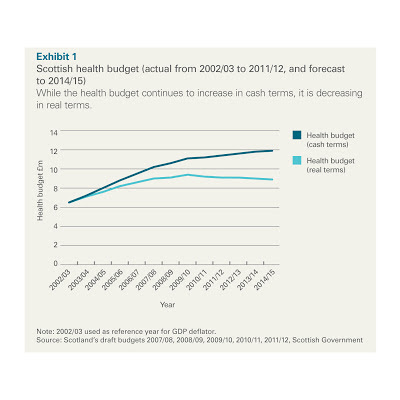Audit
Scotland has published NHS
financial performance 2011/12, an overview of the financial
performance of the NHS in Scotland in the last financial year. It shows a
picture of increasing financial pressure on health boards as the real term cuts
bite.
Although
the overall health budget has continued to increase in cash terms, it has been
decreasing in real terms since 2009/10 and is projected to decrease further in
real terms for the next three years. The
NHS continues to face significant pressures that will make it difficult to
reduce costs while maintaining high-quality services. Demand for services
continues to grow, particularly due to an ageing population; it is becoming
more difficult to identify recurring savings as early opportunities have
already been targeted. Building maintenance (£1bn backlog) and rising drug
costs (+3.2%) are highlighted in the report. Spending on heating and lighting
increased by 5.8 per cent on the previous year.
Three of the 14 territorial boards (Fife, Forth
Valley and Orkney) would not have broken even without additional financial
support from the government. As
the three boards are using £6.2 million of capital to repay their revenue
brokerage, these funds will not be available to the overall NHS capital budget.
There is also a risk that the investment needed to maintain and develop the
clinical estate, equipment and ICT will be unaffordable.
Nine
territorial boards reported an underlying recurring deficit in 2011/12. Around
20 per cent of savings (£67 million) were non-recurring in 2011/12. This means
that boards need to make further savings of £67 million immediately in 2012/13
just to be level with the 2011/12 position. These £67 million savings are
included in the 2012/13 savings target of £272 million. Each year, it becomes
more difficult for boards to find recurring savings.
Eight
boards have categorised at least a quarter of their savings plans as high risk,
with NHS Lothian stating that two-thirds of its savings plans are high risk.
Overall, 20 per cent of the savings target is classified as high risk, raising
concern about the achievability of the savings plans and boards’ ability to
break even in 2012/13.
The
NHS in Scotland employed 131,172 people (135,823 at 30 September 2009). Further
reductions in staff numbers are expected reducing to 130,370 by March 2013.
This represents a cumulative reduction of four per cent since 30 September
2009. While there have been increases in medical and dental staff over this
period, nursing and midwifery numbers are forecast to reduce by four per cent.
The largest decrease will be in administrative staff (8.1 per cent).
In
2011/12, total spending on PFI charges was £184.5 million (£154.1 million in
2010/11). This was due primarily to increases in charges of £15.7 million in
NHS Forth Valley and £8.1 million at NHS Fife, as a result of the completion of
the new PFI projects at the Forth Valley Royal Hospital in Larbert and Victoria
Hospital in Kirkcaldy. PFI charges are a significant financial commitment for
boards.
Auditor
General for Scotland, Caroline
Gardner, said:
“The
NHS in Scotland continues to manage its finances within its total budget, and
has achieved this for the fourth year in a row. The annual accounts show a
picture of good financial performance, but this doesn’t reflect the pressure
boards faced in achieving this. Money was moved between boards, several relied
on non-recurring savings, and some needed extra help from the Scottish
Government to break even in 2011/12. The requirement for boards to break even
each year encourages a short-term view, and the NHS needs to increase its focus
on longer-term financial planning.”

i love you fozia
ReplyDelete